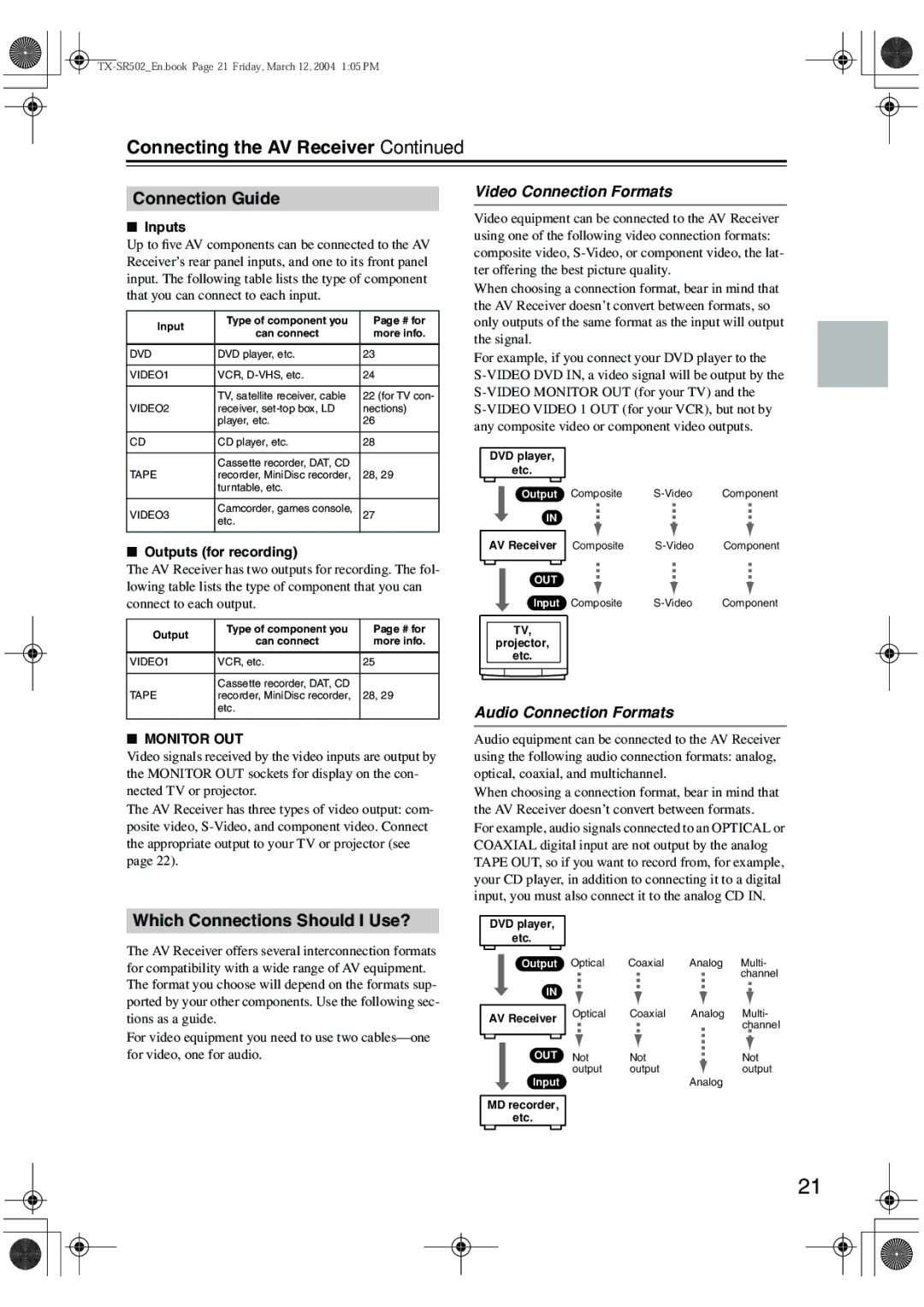
Connecting the AV Receiver—Continued
Connection Guide
■Inputs
Up to five AV components can be connected to the AV Receiver’s rear panel inputs, and one to its front panel input. The following table lists the type of component that you can connect to each input.
Input | Type of component you | Page # for | |
can connect | more info. | ||
| |||
|
|
| |
DVD | DVD player, etc. | 23 | |
|
|
| |
VIDEO1 | VCR, | 24 | |
|
|
| |
| TV, satellite receiver, cable | 22 (for TV con- | |
VIDEO2 | receiver, | nections) | |
| player, etc. | 26 | |
|
|
| |
CD | CD player, etc. | 28 |
Video Connection Formats
Video equipment can be connected to the AV Receiver using one of the following video connection formats: composite video,
When choosing a connection format, bear in mind that the AV Receiver doesn’t convert between formats, so only outputs of the same format as the input will output the signal.
For example, if you connect your DVD player to the
| Cassette recorder, DAT, CD |
| |
TAPE | recorder, MiniDisc recorder, 28, 29 | ||
| turntable, etc. |
| |
|
|
| |
VIDEO3 | Camcorder, games console, | 27 | |
etc. | |||
|
| ||
■Outputs (for recording)
The AV Receiver has two outputs for recording. The fol- lowing table lists the type of component that you can connect to each output.
Output | Type of component you | Page # for | |
can connect | more info. | ||
| |||
|
|
| |
VIDEO1 | VCR, etc. | 25 | |
|
|
| |
| Cassette recorder, DAT, CD |
| |
TAPE | recorder, MiniDisc recorder, | 28, 29 |
DVD player,
etc.
Output
IN
AV Receiver
OUT
Input
TV,
projector,
etc.
Composite
Composite
Composite
etc. |
■MONITOR OUT
Video signals received by the video inputs are output by the MONITOR OUT sockets for display on the con- nected TV or projector.
The AV Receiver has three types of video output: com- posite video,
Audio Connection Formats
Audio equipment can be connected to the AV Receiver using the following audio connection formats: analog, optical, coaxial, and multichannel.
When choosing a connection format, bear in mind that the AV Receiver doesn’t convert between formats.
For example, audio signals connected to an OPTICAL or COAXIAL digital input are not output by the analog TAPE OUT, so if you want to record from, for example, your CD player, in addition to connecting it to a digital input, you must also connect it to the analog CD IN.
Which Connections Should I Use?
The AV Receiver offers several interconnection formats for compatibility with a wide range of AV equipment. The format you choose will depend on the formats sup- ported by your other components. Use the following sec- tions as a guide.
For video equipment you need to use two
DVD player,
etc.
Output
IN
AV Receiver
OUT
Input
Optical | Coaxial | Analog | Multi- |
|
|
| channel |
Optical | Coaxial | Analog | Multi- |
|
|
| channel |
Not | Not |
| Not |
output | output |
| output |
|
| Analog |
|
MD recorder,
etc.
21
